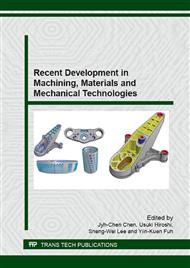p.185
p.191
p.198
p.204
p.208
p.214
p.220
p.226
p.231
Effect of Cutting Conditions on Tool Wear in Driven Rotary Cutting of Maraging Steel
Abstract:
In this paper, driven rotary cutting of maraging steel was carried out and the influence on tool wear of difference cutting conditions was investigated. As cutting conditions, different coolant conditions, cutting speeds, circumferential velocity ratios, tool inclination angles, tool rotation directions and normal rake angles were tested. We found that as the coolant quantity decreased and cutting speed increased, the width of flank wear increased. It was also found that the circumferential velocity ratio, tool inclination angle, tool rotation direction and normal rake angle have optimal conditions that decrease wear. Optimal conditions were chosen, and a tool life test was carried out. As a result, driven rotary cutting was achieved with 11 or more times the tool life of conventional turning.
Info:
Periodical:
Pages:
208-213
Citation:
Online since:
July 2015
Keywords:
Price:
Сopyright:
© 2015 Trans Tech Publications Ltd. All Rights Reserved
Share:
Citation:


